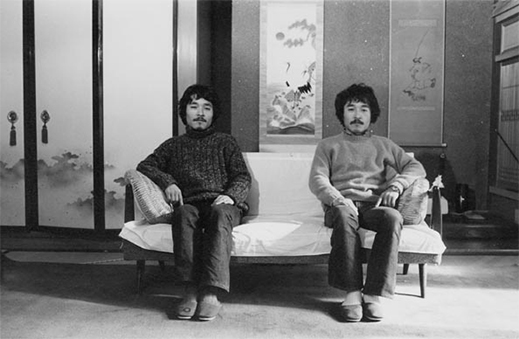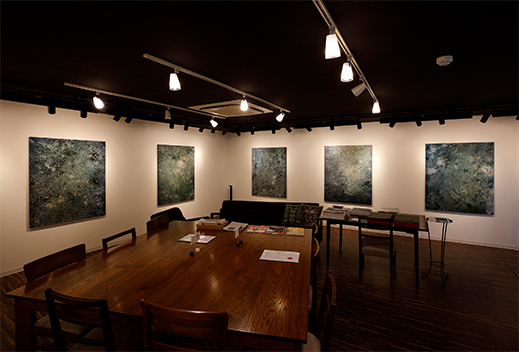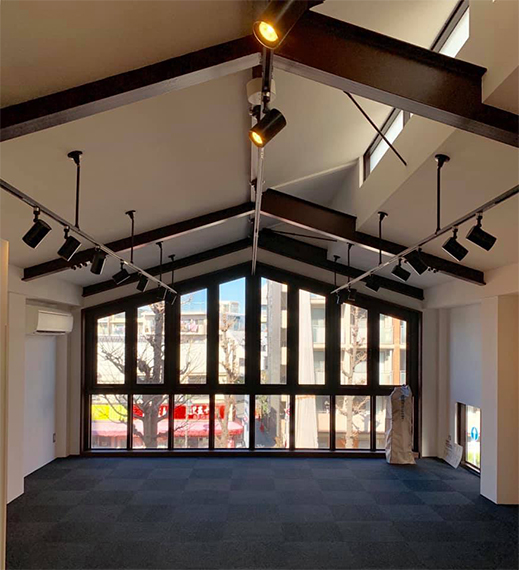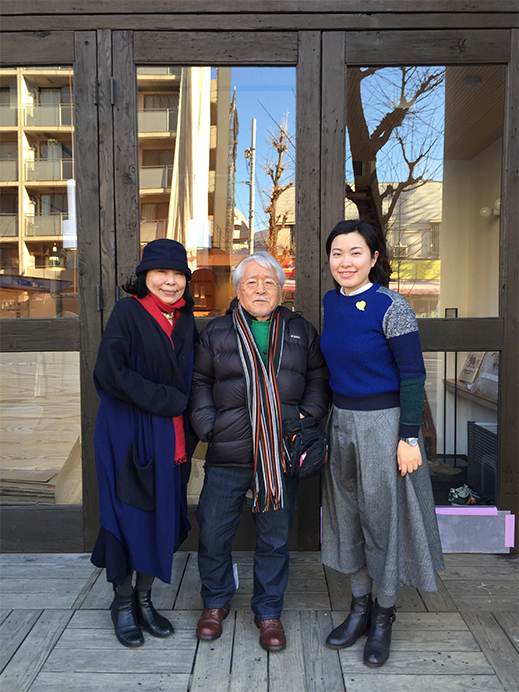 |
|
Here and There introduces art, artists, galleries and museums around Japan that non-Japanese readers and first-time visitors may find of particular interest. The writer claims no art expertise, just a subjective viewpoint acquired over many years' residence in Japan.
|
|
 |
|
|
 |
 |
Aging as a Work in Progress: Hiromi Tsuchida at Fugensha
Alan Gleason |
 |
A small fraction of Hiromi Tsuchida's Aging series of self-portraits photographed nearly every day since 1986 for 33 years. To see a larger section of the series from 1998 to 2007, click here. Courtesy of Hiromi Tsuchida |
One day in 1986, photographer Hiromi Tsuchida looked in the mirror and noticed his hair was turning gray. Since then he has adhered to a daily ritual of snapping his own photo with the help of a self-timer. Allowing for a few missed days, that's over 10,000 self-portraits to date. From 5 February to 1 March, Fugensha Communication Gallery will inaugurate its new venue in Meguro, Tokyo with Aging 1986-2018, a solo show covering the first 33 years of Tsuchida's still-ongoing project.
Change over time has been a recurring theme throughout Tsuchida's career as a freelance photographer. He is known for extended series for which he returns to the same location year after year to record long-term social and environmental transformations, often in fixed-point sequences. This inclination has taken him to postwar Hiroshima, the nuclear no-go zone in Fukushima, and Berlin before and after the fall of the wall. This year he will revisit Israel to chronicle the latest changes in the city of Jerusalem. With Aging he applies the same approach to his own face. The process as revealed here is slow and subtle -- barely perceptible from day to day -- but the cumulative effect of these relentless rows of headshots is dramatic. As Tsuchida no doubt intuited, the emotions we experience about growing old are so universal that using his own face as a sample does not seem at all narcissistic.
 |
|
 |
|
|
|
One-meter-square displays of all the faces photographed during the years 2001 (left) and 2018 (right). Courtesy of Hiromi Tsuchida |
Tsuchida has experimented with different modes of presenting the massive quantity of image data he has accumulated. A six-minute video flashes through all 10,000 faces at the rate of 30 -- about one month's worth -- per second (look here for an earlier version through 2006). A 4.5-meter-long print of the entire series covers one wall. Most of the show, however, is devoted to a set of 33 one-meter-square montages, each containing all the portraits for a given year.
Asked why he began the series when he did, Tsuchida explains that he was spurred by a growing awareness of not just his own aging, but that of Japanese society as a whole -- an issue that began to attract attention in the 1980s. He adds that he is further motivated by the fact that he has an identical twin brother, also still alive and well at age 80. Being a twin, he says, means that your identity is never completely yours alone -- he has always felt like a "clone" of sorts. As he and his twin age, Tsuchida says he has had to confront the reality that whichever brother dies first, it will be a traumatic event for the survivor.
 |
|
Hiromi Tsuchida (right) and his twin brother in 1974, from the series Awase-kagami (Facing Mirrors). Courtesy of Hiromi Tsuchida |
A publicity image for Aging of a calendar for February 2020, with self-portraits taken on each day of the month in successive years from 1987 to 2018. Courtesy of Hiromi Tsuchida |
This is the photographer's first show at Fugensha, a gallery owned by the Watanabe Art Printing Company. It's a family business: president Kaoru Sekine's father founded the firm in 1950, and her daughter Fumi manages the gallery. They opened Fugensha in Tokyo's downtown Tsukiji district six years ago as part of a complex that included a bookstore/café, an event space, and a print service and workshop, Digital Lab Papyrus, equipped with several large inkjet printers for use by photographers. Kaoru Sekine explains that the digital revolution of recent years has been hard on the printing industry. As a niche printer specializing in quality art books and photo collections, Watanabe needed to be more active in reaching out to the larger community of artists and customers, she felt. Fugensha was the solution she came up with: "a place where writers, editors, viewers and readers can naturally meet." In addition to regular exhibitions of art and photography, the gallery hosts talks with exhibiting artists, musical performances, and salons on various topics. Since 2016 Fugensha has expanded into book publishing as well.
 |
|
The gallery and meeting room at Fugensha's former location in Tsukiji. Courtesy of Fugensha |
Last year the Sekines learned that the Tsukiji building was slated for demolition to make way for a condo. Looking all over Tokyo for a place to move Fugensha's various operations, they found what they call "the perfect place" -- a three-story building that used to house a furniture store, with large windows and warm, tastefully wrought wooden fixtures throughout. It fronts on Meguro-dori, a major thoroughfare on the southwest side of Tokyo -- some distance from downtown, but smack in the middle of an up-and-coming neighborhood of antique shops, galleries, cafes and boutiques. Also fortuitously, Kaoru and Fumi Sekine attended a seminar by Tsuchida last summer about his Aging project. Struck, Kaoru says, by the "honesty and directness" of Tsuchida's work, as well as an endearingly humorous quality she found in both the images and the man himself, she immediately asked if he would open their Meguro venue with an exhibition of Aging. Tsuchida happily agreed. Since he last did a show dedicated to the project 20 years ago, the time was right for a look at how it has progressed since then, he says.
 |
|
 |
|
|
|
The bookshop on the first floor in Meguro, before and after the movers came. Courtesy of Fugensha |
When I visited the new site in late January, it was the day after the movers had come. The first-floor bookstore space was piled high with books. On the second floor, the Papyrus staff had already installed an impressive bank of inkjet printers. The third-floor gallery was empty, save for a table around which Tsuchida and Kaoru and Fumi Sekine sat and discussed preparations for the show. It's an ideal room for exhibitions: a wall of windows overlooking Meguro-dori admits soft northern light, augmented by a narrow row of eastern windows atop the high vaulted ceiling. Dark brown wooden beams add unobtrusive ornamentation -- a lot like Scandinavian furniture, come to think of it.
The new gallery and the Tsuchida exhibition open on 5 February, with a reception on the 8th from 5 to 7 p.m. Talk events featuring the photographer with various guests are scheduled for the 8th at 3 p.m., the 15th at 2 p.m., and the 22nd at 2 p.m.
 |
|
 |
|
|
|
|
The new third-floor gallery space in Meguro. Courtesy of Fugensha
|
|
From left to right: Kaoru Sekine, Hiromi Tsuchida, and Fumi Sekine in front of Fugensha's new Meguro quarters. Photo by Alan Gleason |
Images published by permission of Hiromi Tsuchida and Fugensha Communication Gallery. |
 |
| Hiromi Tsuchida: Aging 1986-2018 |
| 5 February - 1 March 2020 |
| Fugensha Communication Gallery |
5-3-12 Shimomeguro, Meguro-ku, Tokyo
Phone: 03-6264-3665
Hours: 12 noon to 7 p.m. Tuesday-Friday; to 6 p.m. Saturday-Sunday; "night gallery" to 9 p.m. on 14 and 28 February
Closed Mondays and national holidays (except open 23 February)
Access: 15 minutes' walk west on Meguro-dori Ave. from Meguro Station on the JR Yamanote Line, Metro Nanboku/Mita Line, and Tokyu Meguro Line. Or take Tokyu Bus #01, 02, or 07 from the west exit of Meguro Station, get off at the bus stop "Moto Keibajo Mae" and walk west for 1 minute.
|
|
|
|
| |
 |
Alan Gleason
Alan Gleason is a translator, editor and writer based in Tokyo, where he has lived for over 30 years. In addition to writing about the Japanese art scene he has edited and translated works on Japanese theater (from kabuki to the avant-garde) and music (both traditional and contemporary). |
|
|
|
|
|
|
|
|
|
 |
|